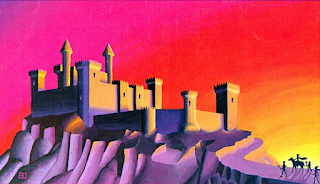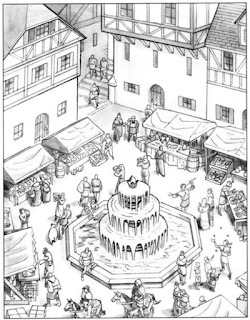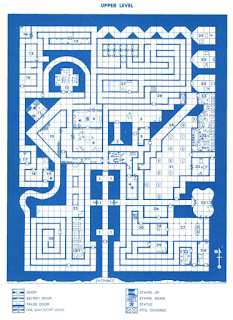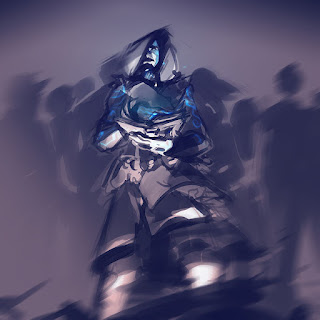“Yea though I walk through the Valley of the shadow of
Death, I shall fear no evil...because I am the meanest motherfucker in the
Valley.”
― Bruce H. Norton, Force Recon Diary, 1969: The Riveting, True-to-Life
Account of Survival and Death in One of the Most Highly Skilled Units in
Vietnam
The Realm of mankind is narrow and constricted. Always
the forces of Chaos press upon its borders, seeking to enslave its populace,
rape its riches, and steal its treasures. If it were not for a stout few, many
in the Realm would indeed fall prey to the evil which surrounds them. Yet,
there are always certain exceptional and brave members of humanity, as well as
similar individuals among its allies — dwarves, elves, and halflings — who rise
above the common level and join battle to stave off the darkness which would
otherwise overwhelm the land. [B2 The Keep on the Borderlands – 6]
Ahead, up the winding road, atop a sheer-walled mount
of stone, looms the great KEEP. Here, at one of civilization's strongholds
between good lands and bad, you will base yourselves and equip for forays
against the wicked monsters who lurk in the wilds. Somewhere nearby, amidst the
dark forests and tangled fens, are the Caves of Chaos where fell creatures lie
in wait. [B2 – 6]
Those passages set the stage for B2 The Keep on the
Borderlands. And the mood. Civilization ends here.
And it most certainly does.
So, where should one place B2? When the adventure was
first published, it was pretty vague about where one would. No mention was made
at all, in fact. Why? Because it was the plug and play, introductory adventure included
within the Basic Dungeons and Dragons Boxed Set, the replacement for Mike
Carrs’ B1 In Search of the Unknown.
B1 was out, B2 was in; but there’s an interesting passage
in B2 that links those two adventures:
51. BOULDER FILLED PASSAGE: Large rocks
and boulders have been placed here in order to seal off this tunnel. It will
take 100 man-turns to open a way large enough for a human to pass through into
the area beyond. (You have the option of allowing this passage to lead to the
outside somewhere to the southwest of the Caves of Chaos, or you may choose to
have it go all the way to the Cave of the Unknown. If you opt for the latter
case, you must, of course, prepare an appropriate underground area map and
stock it with monsters and treasures.) [B2 – 21]
So, where was Quasqueton? The Brown cover edition of B1
is generic. Not so the original monochrome edition:
Note: In the mythical WORLD OF GREYHAWK (available
from TSR) the stronghold can be considered within anyone of the following lands
- the Barony of Ratik, the Duchy of Tenh; or the Theocracy of the Pale. [B1
– In Search of the Unknown monochrome – 6]
Before it was moved to Moldvay’s “Known World”, later Mystara, all content was considered homebrew, or set in Greyhawk. To my reckoning, it was intended to feature the Northern Barbarians, and says as much:
Some years ago, Rogahn and Zelligar apparently decided
upon a joint foray into the lands of the hated barbarians. Taking most of their
henchmen and associates along in a great armed band, the two personages
disappeared into the forbidding alien lands to the north, far from the hills
and forests surrounding Quasqueton. [B1 – 6]
It's because of that passage that I believe its best fit is
Ratik. What lies north of Ratik? The Frost Barbarians, and beyond them, the
Snow Barbarians, and the Ice Barbarians.
The Pale, on the other hand, is surrounded by Nyrond and
Tenh and the Bandit Kingdoms, civilization and not Barbarians. Tenh is
surrounded by the Pale, the Bandits. The Rovers and The Hold of Stonefist are
within reach, but are they barbarians? One might argue that the Rovers are. One
might argue that the Fists are, too.
Myself, I choose Ratik.
And it is because of those words that I disagree with
TSR’s decision to set Return to the Keep of the Borderlands in the
Yeomanry. One might argue that the Yeomanry is narrow, that it lies on the edge
of the realms of mankind, and that it is beset by the forces of Chaos, namely
Giants and such. But its maps show a clear passage to the southeast, leading to
Quasqueton.
The left-hand passage has an arrow and the word
"QUASQUETON" engraved at eye level only a few feet in; this way once
led to the secret fortress of Quasqueton, but the tunnel has completely
collapsed; characters can only go this way thirty feet or so before having to
turn back. In just that space, however, they discover unmistakable signs that
the patient undead are working to clear the passage—a task that will probably
take them several years to complete.
[RttKotB – 31]
Quasqueton is not detailed in the Silver Anniversary’s
scope. Rogahn and Zelligar are not even mentioned. It’s a shame, really.
There’s so much can be read into those NPCs.
To the module itself.
It’s assumed that the module begins with the PCs entering
the keep, but that seems a little blasé to me. Dull, in fact.
Begin with an ambush! Show the players how dangerous this
borderland is! There’s a raider camp nearby, almost on the keep’s doorstep,
after all. After a heated exchange, the PCs take flight, making for the only
refuge in sight, the Keep. During the chase, they catch sight of a figure in
the distance, clad in a black robe with a maroon colored cowl. [B2 – 22]
Once they are safe, they find that the Keep is undermanned. Poorly funded.
Barely capable of defending itself. The Baron is beset! There are bandits in
the woods, lizardmen in the marsh, and his supply chain is constantly under
attack. There hasn’t been a caravan in weeks! He has sent out patrols, but they
have fallen pray to the bandits, and orcs! Or hobgoblins. Or gnolls! Whichever.
He needs your help!
He kits them, maybe he presents them with rooms at the
inn. The keep has just about everything one would need. Walls, inns, taverns, a
smithy, traders, and a bank, etc; all the sundries to keep you going; not bad
for someplace that doesn’t deserve a dot on the map. There’s no town to speak
of, just what’s to be had within the keep. I’d upgrade that, and place the keep
and the town it would require to support it at it’s base. I’d add some farms
around it too. The soldiers have to eat after all. But this was an introductory
module, and I imagine Gary Gygax didn’t want to overwhelm fledgling DM’s. Upgraded,
or not, the PCs have a base of operations. They meet a few of the townsfolk,
including a friendly priest.
The western portion houses the jovial priest who is
taking advantage of his stopover at the KEEP to discuss theology with learned
folk and to convert others. Everyone speaks well of him, although the two
acolytes with him are avoided, as they never speak — the priest says they must
follow vows of silence until they attain priestly standing. His well-appointed
chambers are comfortably furnished and guests are always welcomed with a cozy
fire and plenty of ale or wine. The priest is a very fine companion and an
excellent listener. He does not press his religious beliefs upon any unwilling
person. He is outspoken in his hatred of evil, and if approached by a party of
adventurers seeking the Caves of Chaos, he will certainly accompany them.
[B2 – 9]
Thus begins your campaign.
Where might you begin? With idle chat? The townsfolk
would have a thing or two to say about their town and their valley, wouldn’t
they?
Which brings us to the rumour table. There was always a
rumour table in a module back in those early days. We did love rumour tables
then, didn’t we? They can add insight to any module, if used. But I suggest
perusing them carefully, and working out which NPCs know what. Imagine if a
fairly well-placed NPC relates something false. Should they do, you can figure
out beforehand whether the falsehood was a fib, misdirection, a red herring, or
misunderstanding.
These are pretty standard fare for an early dungeon
module.
Italics denote a false legend or rumor.
- A merchant, imprisoned in the caves, will reward his rescuers.
- A powerful magic-user will destroy all cave invaders.
- Tribes of different creatures live in different caves.
- An ogre sometimes helps the cave dwellers.
- A magic wand was lost in the caves' area.
- All of the cave entrances are trapped.
- If you get lost, beware the eater of men!
- Altars are very dangerous.
- A fair maiden is imprisoned within the
caves.
- "Bree-yark" is goblin-language
for "we surrender"!
- Beware of treachery from within the party.
- The big dog-men live very high in the caves.
- There are hordes of tiny dog-men in the lower caves.
- Piles of magic armor are hoarded in the
southern caves.
- The bugbears in the caves are afraid of dwarves!
- Lizard-men live in the marshes.
- An elf once disappeared across the marshes.
- Beware the mad hermit of the north lands.
- Nobody has ever returned from an
expedition to the caves.
- There is more than one tribe of ores within the caves. [B2 – 7]
The question is, where did these rumours come from? Has
an army of adventurers already pitted themselves against the Caves of Chaos?
They shouldn’t have. No one should know about the caves. They ought to be
secret, lest the Keep would have already stormed their gates, so to speak.
There are foul humanoids gathering there. There is an evil temple there! The baron
would have put an end to it, had he known it existed. But there might have
been a group or two who’d ventured out already, never to return…
The PCs set out, and after a few heated battles against
the raiders, and against a scattering of goblins (just for foreshadowing…),
they can discover that the lizardmen in the hills and hollows may not be as slandered.
I would suggest more sightings of black robes commanding goblins or orcs or
some such, was well, tight-lipped cultists who refuse to speak at all if
captured. They can discover the mad hermit, a survivor of an earlier
adventuring group that had already come across the Caves of Chaos, much to
their dismay, having escaped potential sacrifice with his life, if not his
sanity. Feed him, give him succour, and he could be a valuable source of
information that leads them to the caves.
Should the hermit be a Temple survivor, the jovial
priest’s presence complicates things. The jovial priest is not what he appears
to be, after all:
Note: All are chaotic and evil, being in the KEEP to
spy and defeat those seeking to gain experience by challenging the monsters in
the Caves of Chaos. Once in the caves the priest will use a cause light wounds
(does 2-7 points of damage to the creature touched, a normal "to hit"
roll must be made to touch the victim) or a light spell as needed to hinder
and harm adventurers. Betrayal will always occur during a crucial encounter
with monsters. [B2 – 9]
The hermit may betray the priest’s true nature, or the
priest may silence him. If the hermit does not, the priest will lure the PCs
into danger, or betray them while they confront the Temple.
Let’s add a twist, shall we?
What sort of twist, you ask?
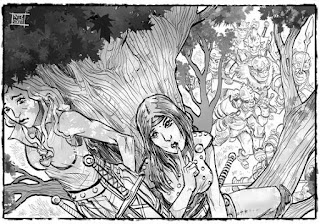 |
| Candella and Duchess |
The party has made their first foray into the caves, and
find the goblins or kobolds a whole lot more tricksy than they anticipated.
There were traps everywhere, and before long, the “goblins” called for help.
There were too many hobgoblins to fight, and the party took flight. They
slipped into a copse of trees, only to discover that they aren’t the only ones
hoping to defy detection. They hear a sharp, “Psst!’ They look up and there
were two young ladies high in the adjacent foliage. One holds a finger to her
lips and winks at them. She smiles. She’s beautiful. They both are. They
gesture for the PCs to climb into the trees, and not long afterwards, the
hobgoblins pass beneath, unaware that their quarry is mere feet above them.
 |
| Candella and Duchess |
If they join the party the two thieves will wait for a
good chance to steal whatever they can (either by trying to pick pockets or
just grabbing any loot in sight), and then run away.
If the thieves are not allowed to join the party, but
are not attacked, they will try to get close enough to a character to try to
pick that person's pockets. If discovered, they will claim that the person made
a mistake, that they merely bumped into the person by accident. If successful
they will leave with their loot. [B3 Palace of the Silver Princess – 24]
Weave those glorious ladies into your campaign. They
help. They join the party. The PCs fall in love with them. The girls abscond
with the loot. Only to be rescued later on in the midst of another adventure.
The PCs are wrongly accused of some crime, the girls break them out. They need
to rescue the girls time and time again. The girls have the key to solving
whatever conundrum the party find themselves in. The possibilities are endless.
What lies ahead? The usual dungeon fare: entry, skulking,
hiding in shadows, the odd combat, potential retreats and maybe the occasion
running for one’s life, and the like.
There’s a lot of good dungeon ecology. Not in that all
those species are within a stone’s throw of one another, but in how some of
them interact. They have guards and secret chambers, and ways to double back
and attack from behind; that their numbers will not replenish when they die,
but they will retreat to other caverns if depleted. And that they will be ready
for further forays by the party. I love how the goblins have worked out a deal
with the ogre.
There’s an owlbear that should be avoided at all costs at
such low level. All the other monsters do, but every now and again a gnoll or
some other unfortunate is made a meal. I’m sure it would love a taste of PC.
If there were any doubt that these gathered humanoids
were up to no good, the party would soon discover otherwise when they find the
slave pens (potentially from where the hermit escaped from), where captured
caravans are awaiting their final fate, and maybe an earlier party of
adventurers that was not as lucky as the PCs thus far (replacements, if necessary).
I especially love this passage:
BUGBEAR LAIR: The group of bugbears is not numerous, but what it lacks in numbers, it makes up for in strength and cunning. There are signs beside the entrance cave in kobold, orcish, goblin, etc. Each says: "Safety, security and repose for all humanoids who enter — WELCOME! (Come in and report to the first guard on the left for a hot meal and bed assignment.)" [B2 – 19]
Personally, I think the numbers might be too high. Were
there that many humanoids in residence, they might already have cut the keep
off and starved it out; conversely, the keep might not be the primary reason as
to why they are there. Besides, do most evil humanoids have the restraint and
the cunning to not destroy humans in such close proximity? They wouldn’t if
some higher power were controlling them. Which brings me to the finale.
The adventure culminates in the discovery and assault on
the evil temple complex high above the rest of the complex. It’s too elaborate
to my mind for it to have been excavated by the Priests and the Acolytes,
without drawing the keep’s attention to their doings long ago.
Who excavated it then? Rogahn and Zelligar? Maybe.
Or maybe, just maybe, it is a relic of an earlier age,
when Keraptis ruled over all the lands that could be surveyed from
long-forgotten Tostencha. These new residents were drawn to this site, much as
Rogahn and Zelligar were, and Keraptis before them. Something drew them there.
Something old. Something incredibly old. And evil.
B2 will take a ton of work to prep. Most early modules do. Okay, they all do. They packed a lot into 30 pages, but there was a prevailing DIY attitude then,
and only so much room between the covers. NPCs need naming. Encounters ought to
be prepped beforehand; unless you want play to bog down while you think about
who prisoners might be, and what they might say while under scrutiny. Etc. Even
today’s 400+ page tomes require work; but these slim volumes always seemed way denser
once you dove in than the weighty volumes do today.
But it needs a town. Keeps do not exist in a vacuum, and what passes for its community within the keep just doesn't cut it. It needs farms too. Etc.
Would I run it as written? Probably not. It’s an
introductory module, and I find it implausible that so many disparate species
of humanoids could be gathered in one place and not kill each other.
I would choose: goblins, hobgoblins, and bugbears (the
goblinoids); or kobolds and orcs, and not the patchwork quilt of enemies as
presented. In either case, I would definitely keep the ogre. If the PCs were
higher level, I’d swap the orcs or hobgoblins for gnolls and flinds.
Would I include the minotaur? Maybe. Probably. It has a
nice tie-in to B1:
28. WORSHIP AREA. The stronghold's
worship area is no more than a token gesture to the gods, it would seem. On the
back wall of the room, opposite the door, is a rock carving of a great idol
which is actually sculpted from the wall itself. The image (of a horned head
with an evil visage) appears about 4' wide and 6' high, and is surrounded by
religious symbols and runes. [B1 – 16]
Is this a perfect module? No. But it is damn close, isn’t
it?
It’s a nearly perfect module insofar as it is a campaign
waiting to happen.
One must always
give credit where credit is due. This post is made possible primarily by the
Imaginings of Gary Gygax and his Old Guard, Lenard Lakofka among them, and the
new old guards, Carl Sargant, James Ward, Roger E. Moore. And Erik Mona, Gary
Holian, Sean Reynolds, Frederick Weining. The list is interminable.
Very special
thanks to E. Gary Gygax, without whose imagination, this adventure, and this
review, could not have been possible, to say nothing of Mike Carr, and Jean
Wells and Tom Moldvay.
The Art:
B2 The Keep on the Borderlands cover, by Jim Roslof, 1981
B2 The Keep on the Borderlands back cover, by Erol Otus, 1981
B2 The Keep on the Borderlands map detail, by David S Laforce, 1980,1981
Zelligar and the Barbarians, from Into the Borderlands, by Goodman Games, 2018
Return to the Keep on the Borderlands map detail, by Todd Gamble, 1999
B2 The Keep on the Borderlands Keep map, by David S Laforce, 1980,1981
The Keep Square, from Into the Borderlands, by Goodman Games, 2018
Minotaur illustration, from B2 The Keep on the Borderlands, by Bill Willingham, 1981
Hermit illustration, from B2 The Keep on the Borderlands, by Erol Otus, 1980,1981
Owlbear illustration, from B2 The Keep on the Borderlands, by by Jim Roslof, 1981
The Worship Area, from Into the Borderlands, by Goodman Games, 2018
The Caves of Chaos map, from B2 The Keep on the Borderlands, by David S Laforce, 1980,1981
Sources:
9025 World of
Greyhawk Folio, 1980
1015 World of
Greyhawk Boxed Set, 1983
2011A Dungeon
Masters Guide, 1st Ed., 1979
9023
B1 In Search the Unknown, Monochrome edition, 1979
9023
B1 In Search of the Unknown, Brown cover, 1981
9044
B3 Palace of the Silver Princess, 1981
9034 B2 The Keep on the Borderlands, 1980
11327
Return to the Keep on the Borderlands, 1999
OJ Oerth
Journal #1 & #11, appearing on Greyhawk Online

